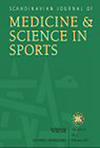How Do Fluctuations in Endogenous Sex Hormones Affect Breast Pain in Female Athletes?
IF 3.8
2区 医学
Q1 SPORT SCIENCES
引用次数: 0
Abstract
Cyclic breast pain (mastalgia) is speculatively associated with hormonal fluctuations during the menstrual cycle. No research to date has quantified this effect through circulating concentrations of estradiol and progesterone in a sample of female athletes. Such data are essential for understanding how hormonal changes contribute to the incidence and severity of cyclic breast pain, with implications for enhancing breast pain management and athletic performance in women's sport. Twenty‐four female Australian First Nation athletes from the National Rugby League Indigenous Women's Academy pathways program participated in a Female Athlete Research Camp. Over 5 weeks, participants completed a daily survey about their experience of breast pain and, at three approximate phases of the menstrual cycle (Phases 1, 2, and 4), presented to the laboratory for venous blood samples to track circulating estradiol and progesterone concentrations. Average mastalgia ratings spiked during the commencement of the menstrual period and 14–26 h prior to ovulation. Higher levels of estradiol and progesterone were associated with a decreased likelihood of experiencing mastalgia; elevated progesterone levels were also linked to a reduction in mastalgia severity. These effects were highly interdependent, such that the effect that progesterone had on mastalgia was dependent on the value of estradiol, and vice versa. This study provides the first quantitative evidence that circulating estradiol and progesterone levels influence the occurrence and severity of cyclic breast pain in female athletes. These findings support the development of targeted strategies for managing mastalgia, ultimately promoting well‐being and enhancing performance for women in sport.内源性性激素的波动如何影响女运动员的乳房疼痛?
周期性乳房疼痛(乳房痛)推测与月经周期中的激素波动有关。迄今为止,还没有研究通过女性运动员样本中雌二醇和黄体酮的循环浓度来量化这种影响。这些数据对于了解激素变化如何影响周期性乳房疼痛的发生率和严重程度至关重要,对加强乳房疼痛管理和女性运动表现具有重要意义。来自国家橄榄球联盟土著妇女学院途径项目的24名澳大利亚第一民族女运动员参加了女运动员研究营。在5周的时间里,参与者完成了关于乳房疼痛经历的每日调查,并在月经周期的三个大致阶段(第1、2和4期),将静脉血样本送到实验室,以跟踪循环雌二醇和黄体酮的浓度。在月经期开始和排卵前14-26小时,乳房痛的平均评分飙升。较高水平的雌二醇和黄体酮与经历乳房痛的可能性降低有关;孕酮水平升高也与乳房痛严重程度的减轻有关。这些影响是高度相互依赖的,比如黄体酮对乳房痛的影响取决于雌二醇的值,反之亦然。本研究首次提供了定量证据,证明循环雌二醇和孕酮水平影响女性运动员周期性乳房疼痛的发生和严重程度。这些发现支持有针对性的策略来管理乳房痛,最终促进健康和提高女性在运动中的表现。
本文章由计算机程序翻译,如有差异,请以英文原文为准。
求助全文
约1分钟内获得全文
求助全文
来源期刊
CiteScore
7.90
自引率
4.90%
发文量
162
审稿时长
3 months
期刊介绍:
The Scandinavian Journal of Medicine & Science in Sports is a multidisciplinary journal published 12 times per year under the auspices of the Scandinavian Foundation of Medicine and Science in Sports.
It aims to publish high quality and impactful articles in the fields of orthopaedics, rehabilitation and sports medicine, exercise physiology and biochemistry, biomechanics and motor control, health and disease relating to sport, exercise and physical activity, as well as on the social and behavioural aspects of sport and exercise.

 求助内容:
求助内容: 应助结果提醒方式:
应助结果提醒方式:


